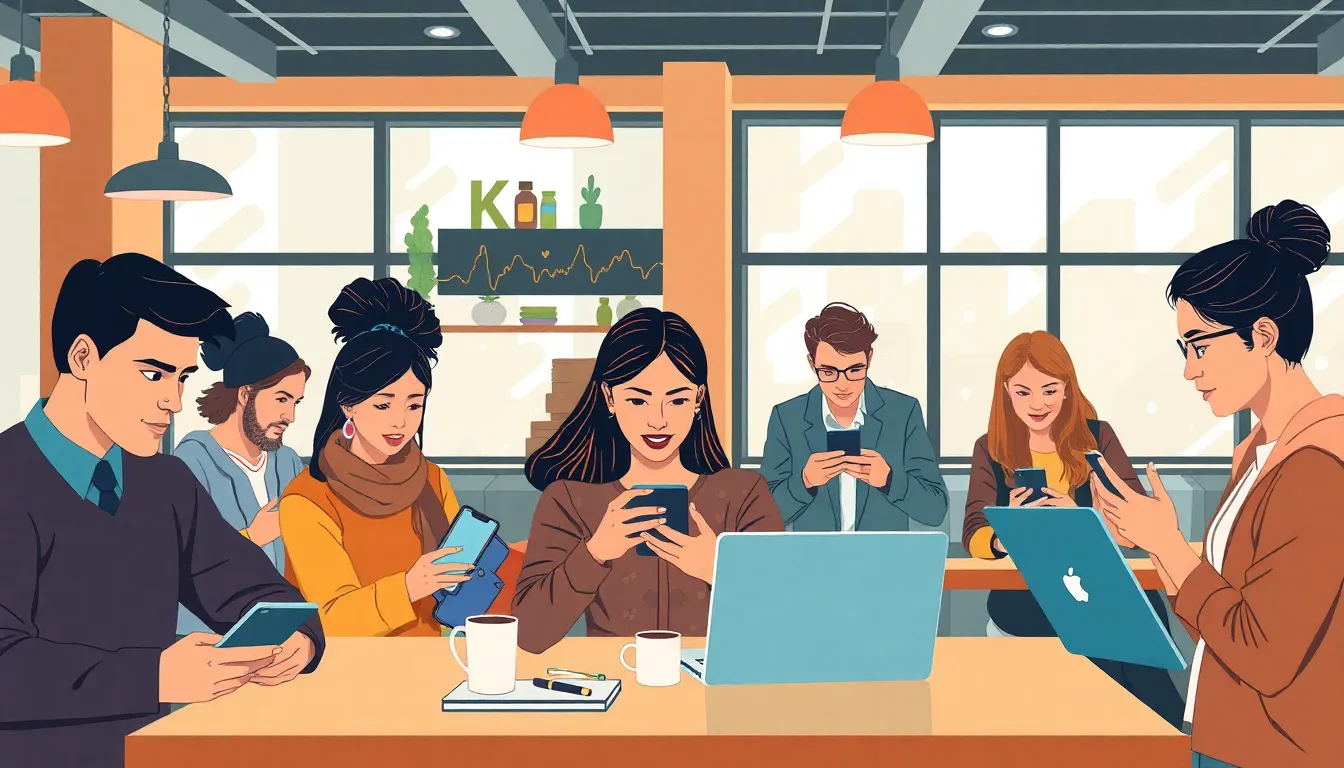In today’s world, technology isn’t just a tool; it’s practically a member of the family. From smartphones that wake you up with a gentle nudge to smart fridges that remind you when you’re out of milk, it’s hard to imagine life without these digital companions. They’re like that overly helpful friend who always knows what you need—sometimes a little too well.
But let’s be honest: while technology makes life easier, it can also be a source of endless amusement. Who hasn’t laughed at their smart assistant misinterpreting a simple command? As technology weaves itself into the fabric of daily life, it’s reshaping how we communicate, work, and even relax. Buckle up as we explore the quirks and conveniences of living in a tech-savvy world.
Table of Contents
ToggleThe Role of Technology in Everyday Life
Technology enhances daily routines through various applications. Smartphones enable instant communication, allowing conversations to occur instantly across distances. Smart home devices automate tasks, providing comfort and efficiency. For example, smart thermostats adjust temperatures automatically, optimizing energy consumption.
Virtual meeting platforms facilitate remote work, shifting traditional office dynamics. Teams collaborate seamlessly from different locations, increasing global connectivity. Video conferencing tools support face-to-face interactions, maintaining personal connections even when physically apart.
Social media platforms foster interpersonal relationships. Users share experiences and connect with friends, family, and interest groups. These platforms enable individuals to discover communities and engage in meaningful discussions.
Entertainment also receives a technological boost. Streaming services provide immediate access to vast content libraries, changing how people consume media. Gaming consoles offer immersive experiences, creating interactive fun for friends and families.
Health and fitness apps empower individuals to track activity and monitor wellness. Users receive personalized recommendations, encouraging healthier lifestyles. Wearable devices provide real-time data, improving personal accountability in fitness regimens.
Shopping experiences transform through technology as e-commerce platforms gain popularity. Consumers enjoy convenience, comparing prices and accessing products from anywhere. Augmented reality features enhance virtual try-ons, bridging the gap between online shopping and physical stores.
Education transforms with technology’s integration. Online courses make learning accessible, providing resources for personal and professional growth. E-learning platforms cater to diverse learning styles, enhancing knowledge acquisition.
Each of these technological advancements shapes daily life. Tasks that once consumed time now streamline experiences, allowing greater focus on personal interactions and enjoyment.
Impact of Technology on Communication

Technology profoundly transforms communication methods. It streamlines interactions, enhances connectivity, and fosters relationships across distances.
Social Media Influence
Social media platforms redefine how individuals connect. Users share updates, thoughts, and experiences with a global audience. These platforms facilitate real-time conversations, allowing instant feedback and engagement. According to statistics, 4.9 billion people actively use social media worldwide. Enhanced visibility promotes personal branding and community building, impacting both personal and professional relationships. Businesses utilize these networks for marketing, directly engaging with customers, and receiving valuable feedback. The instant nature of social media encourages users to stay updated on trends, news, and events, fostering an interconnected ecosystem. Overall, social media amplifies voices and creates spaces for dialogue and expression.
Instant Messaging Applications
Instant messaging applications enhance daily communication with speed and convenience. They provide a platform for direct conversations, allowing users to send texts, voice notes, and make video calls. As of 2023, over 1.5 billion people use WhatsApp alone. This accessibility encourages real-time interactions, making long-distance communication feel immediate. Group chats enable collaboration among teams and families, streamlining dialogue and information sharing. Features like read receipts and typing indicators further facilitate engagement, keeping conversations dynamic. Instant messaging not only supports personal connections but also fosters professional interactions, with many businesses integrating these tools into customer service strategies. Through these applications, communication becomes seamless and integrated into everyday life.
Technology in Home Life
Technology enhances home life by providing convenience and comfort. Smart home devices play a significant role in this transformation.
Smart Home Devices
Smart home devices streamline daily routines through automation and control. These gadgets include smart thermostats, security cameras, and voice assistants. Smart thermostats adjust temperatures automatically, improving energy efficiency and comfort. Security cameras offer real-time monitoring, enhancing home security. Voice assistants respond to spoken commands, allowing users to control various devices with ease. According to Statista, the global smart home market is projected to reach $174 billion by 2025, indicating widespread adoption. These devices create a connected ecosystem, making home management intuitive and user-friendly.
Online Shopping Trends
Online shopping has rapidly transformed consumer behavior. E-commerce platforms simplify the purchasing process, offering convenience and access to a vast selection of products. Mobile apps provide a user-friendly interface, allowing shoppers to browse, compare, and purchase items quickly. Reports show that global e-commerce sales reached $5.2 trillion in 2020, with a steady increase expected each year. Features like augmented reality assist consumers in visualizing products in their homes before buying. Personalized recommendations enhance the shopping experience, making it easier for individuals to discover products suited to their preferences. This evolution in shopping habits reflects the seamless integration of technology into everyday life.
Technology in Education
Technology plays a crucial role in education, enhancing learning experiences and accessibility.
E-Learning Platforms
E-learning platforms revolutionize traditional learning methods by providing interactive and flexible access to educational resources. Applications like Coursera and edX offer thousands of online courses from renowned universities, enabling students to learn at their own pace. In 2021, the global e-learning market reached $250 billion and continues to expand as more institutions adopt this model. Real-time feedback mechanisms integrated into these platforms help improve student engagement and comprehension. Furthermore, mobile compatibility allows learners to access content anytime, anywhere, maximizing convenience and encouraging lifelong education.
Access to Information
Access to information becomes vastly improved through technology in education. The internet hosts an abundance of resources, including research articles, videos, and ebooks. According to recent studies, over 90 percent of students use online resources for assignments. Search engines simplify the process, enabling quick retrieval of information. Wikipedia serves as a go-to for introductory knowledge across subjects. Additionally, platforms like Google Scholar offer academic articles, providing credibility and depth to research. This easy access encourages critical thinking and fosters independent learning among students.
Health and Fitness Technology
Technology plays a pivotal role in enhancing health and fitness in everyday life. Wearable devices and health monitoring apps provide users with unprecedented access to their wellness data.
Wearable Devices
Wearable devices like fitness trackers and smartwatches enable users to monitor their daily activity levels. Users can track steps, heart rates, and sleep patterns, gaining insights into their overall health. For instance, Fitbit reported over 29 million active users in 2022, showcasing the growing popularity of these devices. Apple Watch includes features that support health monitoring, such as ECG and blood oxygen measurement. Data gathered from wearables helps users set personal goals and stay motivated in their fitness journeys.
Health Monitoring Apps
Health monitoring apps assist individuals in tracking various aspects of their well-being. Many apps enable users to log workouts, manage dietary habits, and monitor hydration. MyFitnessPal, for instance, boasts over 200 million users who record their meals and exercise. These apps can sync with wearables, providing a comprehensive view of one’s health data. Users can receive personalized recommendations based on their inputs and goals, further enhancing their wellness efforts. Integration with telemedicine also allows users to consult healthcare professionals from the comfort of their homes.
Technology’s influence on everyday life is undeniable. From enhancing communication to transforming home environments it shapes how people interact and function daily. The convenience offered by smart devices and applications streamlines tasks allowing individuals to focus on what truly matters.
As technology continues to evolve it will further redefine experiences in education health and shopping. Embracing these advancements not only improves efficiency but also fosters deeper connections and enriches personal lives. The journey of integrating technology into daily routines is just beginning and its potential remains vast and exciting.




